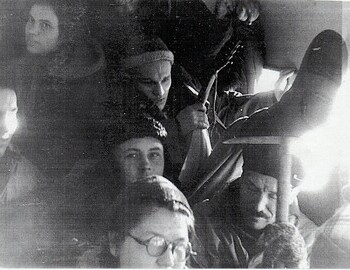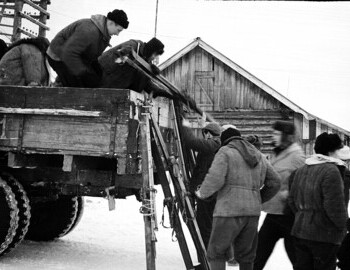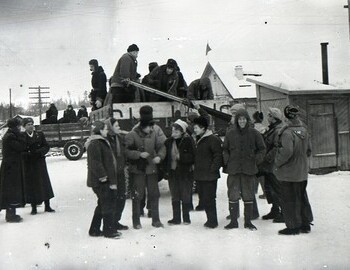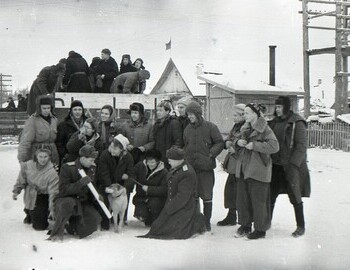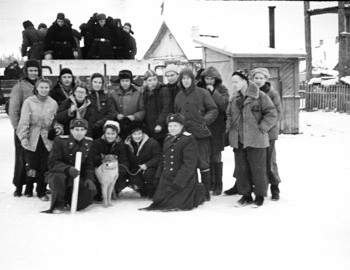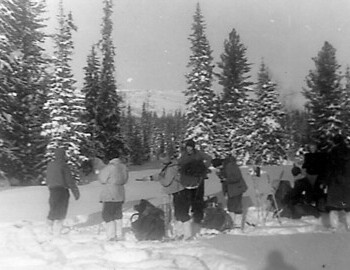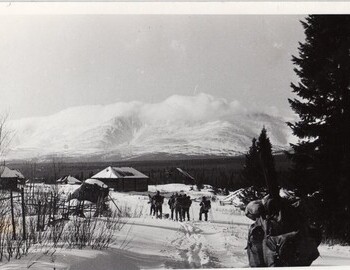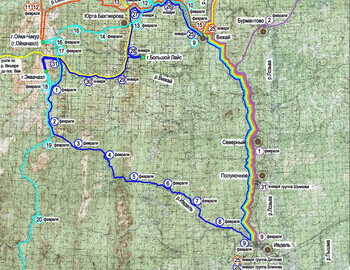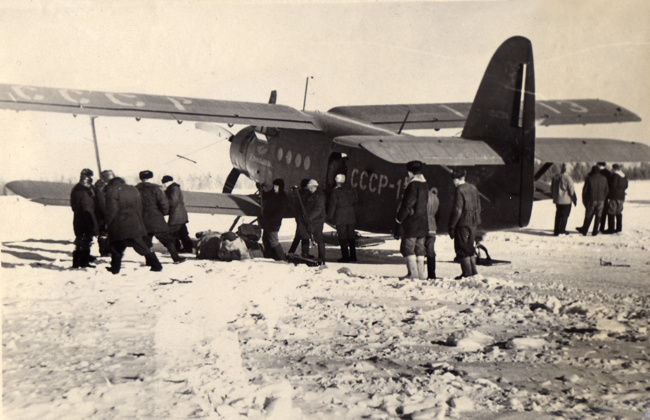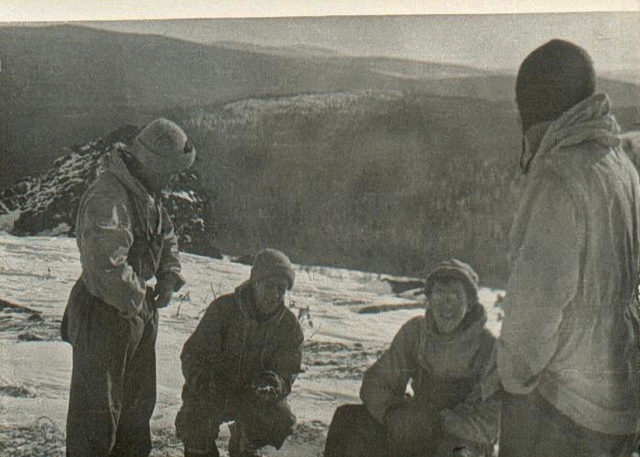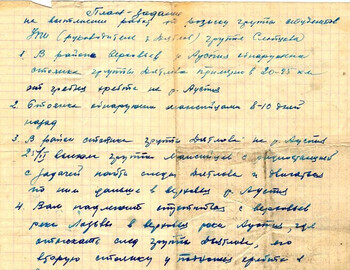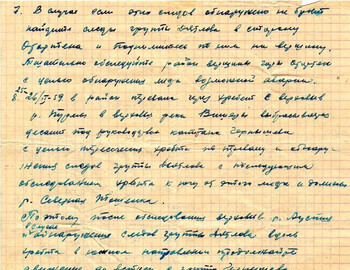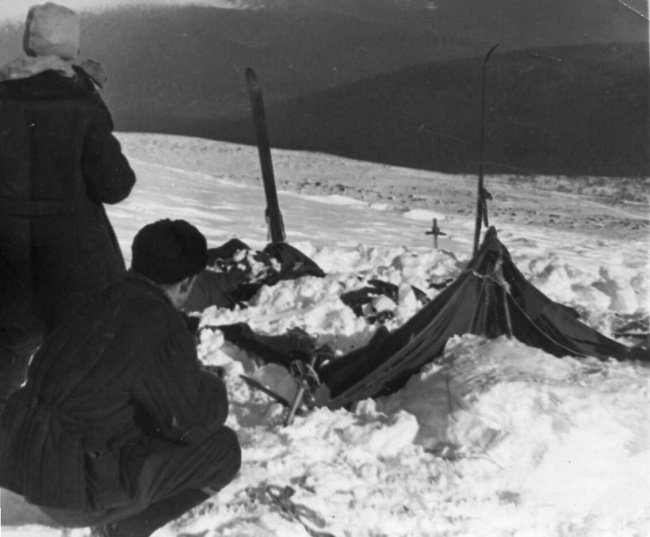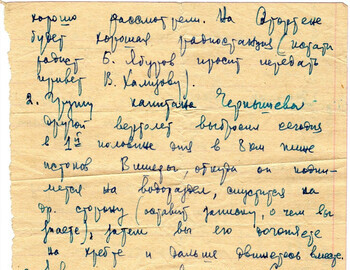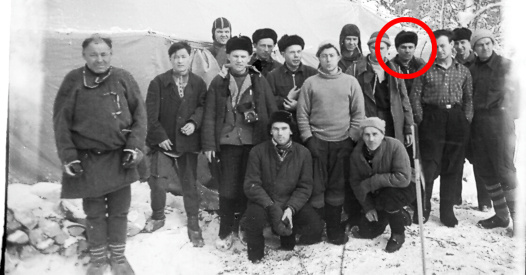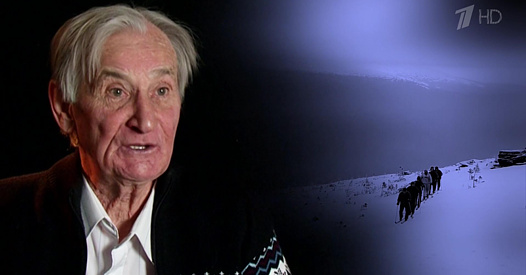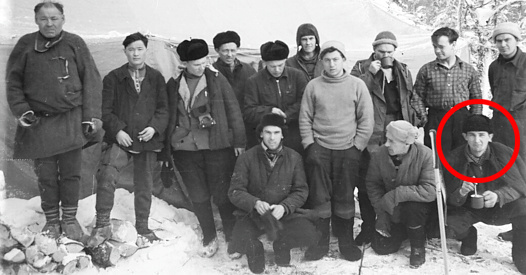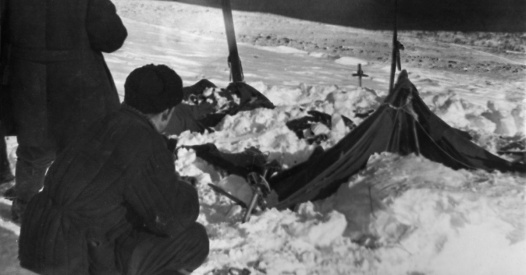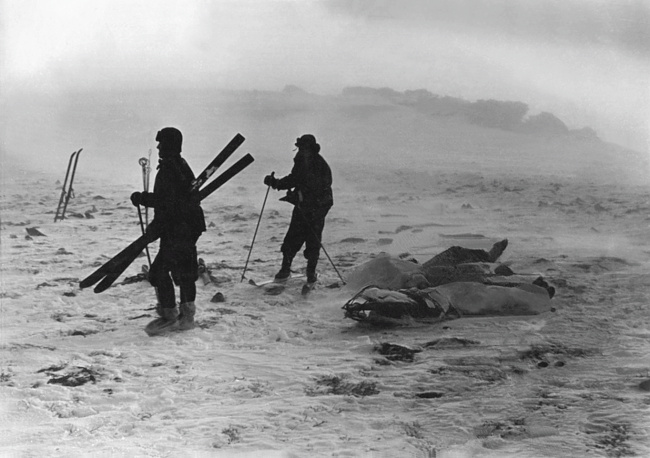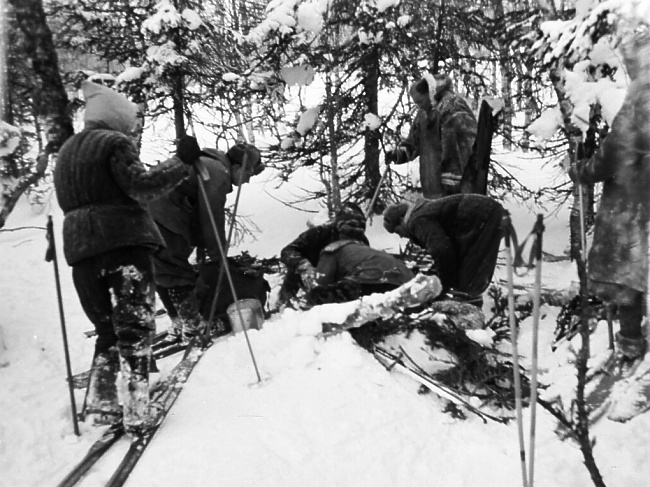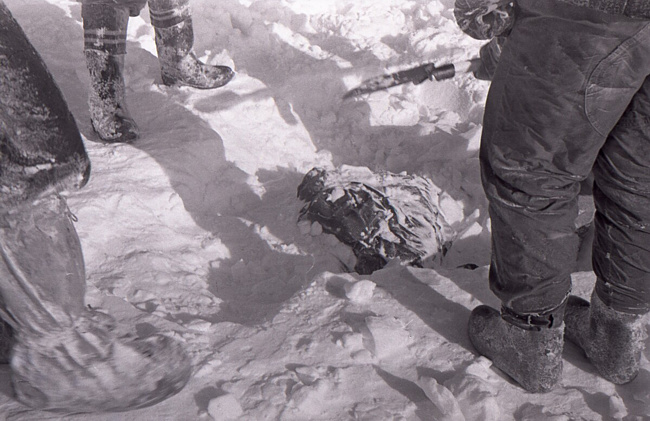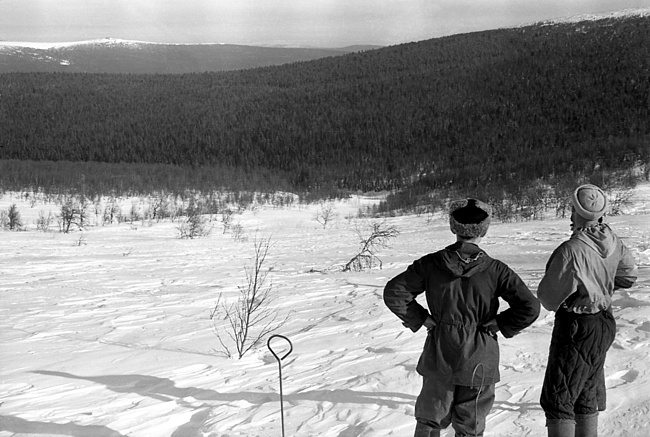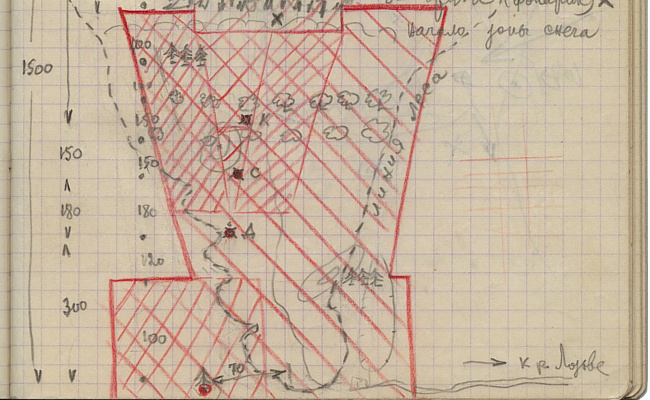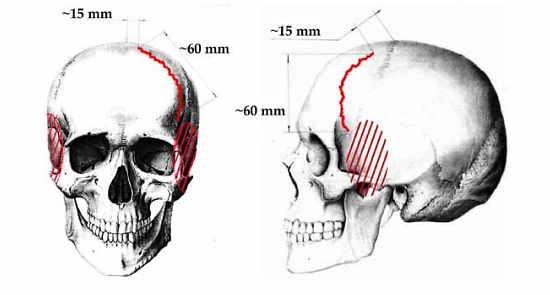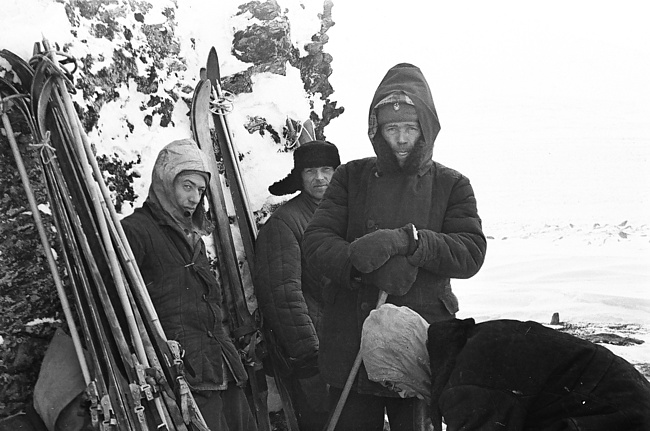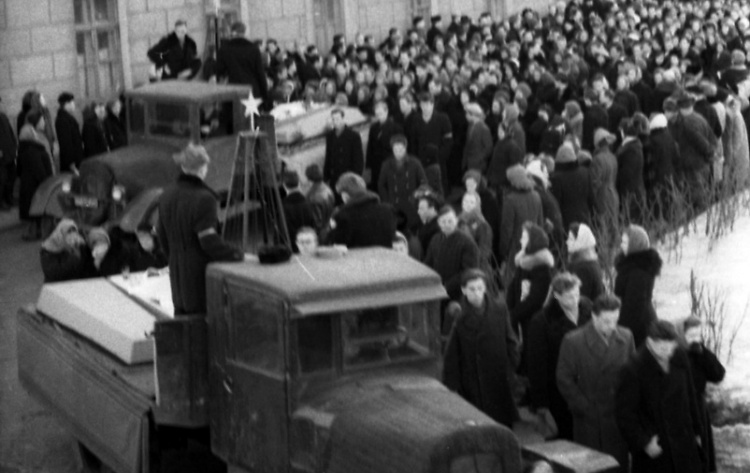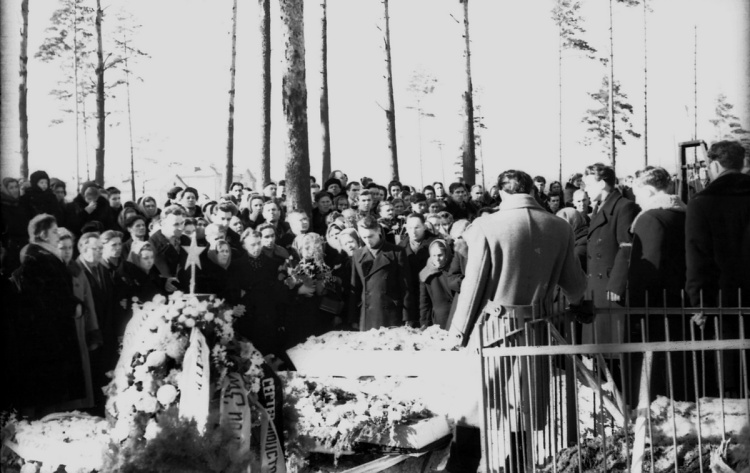
Chronology part 2 - First group of bodies
Excerpts © "1079 The overwhelming force of Dyatlov Pass"
On February 11, some of the UPI courses and departments have already started classes. The UPI hikers were returning from their treks. Yuri Blinov’s group had returned with a two-day delay after the deadline. They had covered more than 200 km (124 miles), conquering the peaks of Molebniy Kamen (Prayer Stone), Martay, Beliy Kamen (White Stone), and Denezhkin Kamen (Money Stone). They had met with the Mansi in the headwaters of the Vizhay River and with a group of Moscovites traversing from the Perm Region towards the Denezhkin Kamen. The temperatures had dropped to -50°С (-58°F), but the hikers had overcome all hardships.
In the region of Vizhay-Burmantovo-District 41 there are 6 groups that hiked in late January 1959: Pyotr Shtiglits - not confirmed, not on the map, Igor Dyatlov (10), Yuri Blinov (10) - he did not keep a diary for this trek, Anatoliy Shumkov (10), Igor Fomenko (7), and Vladislav Karelin (8)
On February 12 Slobtsov's group returned. Boris Slobtsov was a third year student of the UPI Department of Power Engineering. They had been to the South Urals, to the Taganay peaks 200 km (124 miles) from Sverdlovsk.
February 12 was as well the deadline for the return of the Dyatlov group. Igor had not sent a telegram from Vizhay with a notification of the end of their trek, however, that didn’t ring any alarm bells at the UPI sports club, nor at the city committee for physical culture and sports. Blinov assumed that given the actual situation along the route, a realistic date for the return of the Dyatlov group to Sverdlovsk might be February 15-16.
For some part of the UPI students, the winter vacations were only beginning. On February 13, a UPI group led by Evgeniy Chubarev set off by a night train from Sverdlovsk on a ski hike along the route of the city of Pokrovsk Uralskiy – Mt. Olvinskiy Kamen – Mt. Konzhakovskiy Kamen – Kytlym settlement – the city of Karpinsk. They would return to Sverdlovsk only on February 27. Maybe at this point his name is not familiar to you, so skipping forward, on the instruction of the prosecutor's office of the Sverdlovsk region, he printed photographs from the films of the Dyatlov group together with Boris Bychkov and Yuri Yudin.
Worried by the absence of his son, Vladimir Mihaylovich Slobodin, the father of Rustem Slobodin, Doctor of Agricultural Sciences, head of the department of the Ural Research Institute of Agriculture, telephoned the UPI sports club. He was told that the return of the Dyatlov group might be delayed until February 16. Most likely, such an answer was based on Blinov’s assumptions. On February 15, the UPI students Galina Radosteva, who was a member of the routing commission of the UPI sports club, and Igor Krivonischenko, the brother of Georgiy (Yuri) Krivonischenko, requested that the UPI labor union committee should send an official inquiry to the Vizhay settlement – the final destination of the Dyatlov group. On February 16, alarmed by the lack of information about the Dyatlov group, Yuri Blinov and Lev Gordo, board chairman of the UPI sports club, initiated an inquiry. Blinov telephoned Valerian Ufimtsev, inspector of the city committee.
It was ascertained that no telegram confirming the completion of the route had been received from the Dyatlov group. The UPI sports club requested a long-distance call with Vizhay. Late in the evening, they were put in touch with Zakiy Hakimov, the head of the Vizhay corrective labor camp branch, who reported that the Dyatlov group had not returned to Vizhay and that they had not planned to return before February 15.
The groups of Karelin and Dyatlov had a common point in their routes - the top of Oyko Chakur, however, on February 16, while climbing it, Karelin did not find any traces of the Dyatlov group. Please take a look at the planned route of the Dyatlov group on the map below. See how far south Oyko Chakur is. Now think about where would you leave a cache with supplies (labaz). Where do routes to and from Otorten intersect? That's right, where the tent will be found on February 26. Food for thought.
On February 17 in Sverdlovsk, there was a mounting concern. Blinov telephoned Ufimtsev for the second time. Rimma Kolevatova, the sister of Aleksander Kolevatov, also called the City sports committee. There had not yet been any telegram from the group, however, Ufimtsev felt certain that there was nothing to worry about. Kolevatova was trying to reach Lev Gordo, but the latter was absent from his office. Later, Gordo would explain that at the time he was trying to arrange for the allocation of an aircraft for the group’s search.
Fast forward, Gordo was fired for his role in the Dyatov case. Among the 5 people who were reprimanded upon closing the case he was the one most severely punished. The other four were Siunov, Zaostrovskiy, Slobodin, and Kurochkin. Case files 384-387
On February 18, Gordo informed the UPI party committee of the situation with the missing group and asked to file a request for an air search with the 123rd flight detachment. Dyatlov's sister came to the party committee meeting with a request to begin the search. For some reason, the information was not brought to the attention of Nikolay Siunov, the Rector of the Institute. As a result, the application was most likely issued on behalf of the UPI sports club. The city committee telegraphed an official request to Vizhay. At the same time, Gordo was calling Vizhay again. He was informed that a group of locals was preparing for the search and that recently someone had seen a group of hikers. Probably that was the Dyatlov group and everything was OK with them. This gave Ufimtsev a reason to tell the parents of Dubinina, who by that time had managed to put through a call to the city committee, that there was no reason to fret.
The desperate relatives of the missing hikers had nothing left but to turn to the authorities for help. Aleksander Dubinin appealed to the Sverdlovsk regional committee of the CPSU to bring the situation to the attention of Afanasiy Eshtokin, the Secretary of the regional committee of the CPSU. Rimma Kolevatova called the city committee of the CPSU. Appeals to party authorities had provoked counter-moves by the authorities. It is possible that the professional standing of some of the parents of the missing hikers had something to do with it. Aleksander Dubinin was a senior engineer at the Office of the Timber Industry Sovnarhoz. His wife was the secretary of Nikolay Semihatov, the director of the Sverdlovsk Research Institute of Automatics, which was developing missile control systems. It appears that an appeal from Georgiy’s (Yuri) father– Aleksey Krivonischenko – could have been the most efficient. He had the rank of Major General of the Engineering Corps, serving as the head of the Urals Power Construction Mechanization which was building the Beloyarsk Nuclear Power Plant. However, his career was not all roses: soon after the death of his son he would be laid off for mishandling his job, and in the spring of that same 1959 he would be transferred to the city of Pavlodar, Kazakh SSR, to serve as head of construction management office of the Yermakovskaya State Hydroelectric Power Plant. According to the reminiscences of the relatives, after his appeal, Krivonischenko was summoned to the Sverdlovsk regional or city party committee. After that, there were no more complaints or appeals.
Local party authorities opened an internal investigation, which was followed by telephone calls to the city committee and the UPI. Ufimtsev had to inform Boris Zhuravlyov, then an instructor of the Sverdlovsk regional committee of the CPSU, about the missing group. Ufimtsev would later say that he informed the regional committee on his initiative. Nikolay Siunov, the UPI rector, was forced to give an account to E.P. Fedchenko, a representative of the Investigating Committee. Later, the bureaucratic machine transformed this into the following message: "On February 19, the Institute turned to the local party and Soviet authorities with a request for assistance in the search for the missing students."
Due to the attention to the situation on the part of the city and regional CPSU committees, the UPI was forced to start the search. Aleksander Kondratyev and Georgiy Ortyukov, the professors at the UPI reserve-officer training department, were called in to assist with the organization.
An agreement was reached with the 123rd flight detachment on detailing an aircraft and a helicopter for the search right at the Ivdel district. We cannot disregard the possibility of preliminary negotiations with Dmitriy Lelyushenko, a four-star General of the Army, then the commander of the Ural Military District, on assistance in conducting the search. The UPI Department of Radio Engineering collaborated with the Ural Military District in 1957 58 by taking part in the development of the new radio reconnaissance systems ("Eye" scientific research project), as well as the systems for creating aimed jamming systems ("Smoke" scientific research project).
Vladimir Aleksandrovich Pervago, the head of the Ural Geological Office, had given assurances of assistance in the search for the group from the Northern Geological Expedition based in Ivdel. Probably that was facilitated by the fact that the children of Pervago studied at the school where Rimma Kolevatova worked. Vladimir Pervago was transferred to Sverdlovsk in 1958, and before that, he had worked in the Far East and South Yakutia.
It was decided that the first search group would fly to Ivdel. The UPI sports club was in charge of the logistics. Gordo was responsible for the material support. Blinov, who had taken part in the preparation of the Dyatlov group trek, was to organize the ground search. Suddenly it turned out that the UPI sports club did not have the Dyatlov group route plan. Lev Milman, an instructor at the UPI and deputy board chairman of the sports club, turned to Nina Anisimova, Aleksander Kolevatov's sister, who worked as a radiologist at the UPI hospital. Nina and Rimma had no map, Aleksander had taken it along with him on the trek. At the sisters' request, Ryagin reconstructed the route from memory and mapped it out. Rimma Kolevatova handed the map in person to Colonel Ortyukov.
Meanwhile, Yudin returned to Sverdlovsk from his native village, Emelyashevka. He was welcomed and quickly barraged with questions, "At last! Is everything OK with the group?" "Were you delayed along the route?" At first, Yuri didn't understand the reason for all the questions. When it dawned on him that his comrades were missing, he fell into a state of shock. For the rest of his life, Yuri Yudin would treasure a small souvenir teddy bear, which Lyuda Dubinina had given him when they bid farewell at the 2nd Northern. Until his death in 2013, Yuri Yudin would be unable to give a coherent account of what happened with him in the first days upon his return to Sverdlovsk, except for a vague memory of his meeting with Andrey Kirilenko, the first secretary of the Sverdlovsk regional committee of the CPSU. "Kirilenko had summoned me and Siunov, the Institute’s Rector. The latter was all a tremble while walking into his office ahead of me. Kirilenko came in and hugged me. He wanted to take a look at me. Why would he want to take a look at an obscure student?"
On February 20, Vladimir Slobodin made another call to the UPI sports club, where he was told that a plane had been sent on a search for the missing group. Gordo and Blinov flew to Ivdel from Uktus in a Yak 12 of the 123rd flight detachment. Following the interference of the party authorities, the pilots could no longer question the mission. The aircraft was personally flown by Ilya Spitsyn and Georgiy Karpushin, the commander and senior navigator of the 123rd flight detachment.
At around 3 PM, there was a telephone call between Ufimtsev and Maslennikov, the chairman of the Region’s Federation for Tourism and a member of the Routing Commission. They decided that the search should be organized by the UPI. It did not take much time for the sports officials to obtain approval from the authorities. The executive committee of the regional soviet was to be responsible for the general oversight. A telegraph notification of the disappearance of the group was sent to all the chairmen of the city, settlement, and village Soviets in the name of Vasiliy Alekseevich Pavlov, the deputy chairman of the Sverdlovsk regional executive committee. The UPI was officially made responsible for the search. Its Rectorate, party, labor union organizations, and sports club were involved. The search headquarters was organized. The UPI tourist section was urgently convening a meeting under the slogan "Dyatlov group emergency". Its participants included Boris Martyushev, the chairman of the tourist section, V.E. Slobodin, the chairman of the union committee, and Andrey Vishnevskiy, head of the Department of Physical Education.
Soon they managed to organize around-the-clock telephone communication with Ivdel. They learned that Gordo and Blinov had landed safely, that the flight had taken three hours. Then Spitsyn and Karpushin got to studying the maps of the area, weather conditions, and information on the movement of the Dyatlov group. According to the most recent information, the group had taken a logging truck to the village of Burmantovo and then left, moving along the winter trail. Local geologists promised to help with recruiting for the search local Mansi hunters, who were familiar with the terrain.
The organization of the first UPI search group began under the supervision of Andrey Vishnevskiy. The selection procedure was not quite clear. On the one hand, the senior students' winter recess had begun a month earlier than the one of the junior students: the former, starting in late January, ended in late February, when junior students were to go on vacation. From the materials of the UPI small newspaper, For Industrial Personnel, we know that the winter term exams for 5th year students had been over by mid-January, with the work on final papers to begin. 4th year students were to complete their examination term by late January. For the 1st, 2nd, and 3rd year students, the winter term examination period lasted from early to late February, with the winter recess of only a single week. The day before, on February 19, 3rd year students of the UPI Department of Radio Engineering had their last exam. Hence it was logical to expect volunteers from among junior students in the search group; however, that was not the case: there was a sufficient number of senior students in the search group, including some who had recently returned from the Blinov group trek. We cannot rule out that participation in the search brought some benefits, such as being granted academic leaves, leniency during pass-fail tests, exams, and final papers.
According to the recollections of Vladimir Lebedev, a participant in the search, he was supposed to lead a 2nd category of difficulty trek to Konzhakovskiy and Denezhkin Kamen. All equipment was ready, except for the skis and the tent, which he had to get from the Dyatlov group. As soon as it became known that Dyatlov group went missing, the inexperienced rookies were removed from the Lebedev group, and the rest became part of the first search group.
Vadim Brusnitsyn, who had taken part in the search, recalled that the labor union committee had to organize the first search group on short notice. Hence, the participants were recruited at random, and they virtually did not know each other. Boris Slobtsov was appointed the group’s leader since he was the first to enlist into the search group. Brusnitsyn was the second to sign up. This partly explains why it was Slobtsov who was appointed the leader of the search group even though the group included more experienced hikers, for instance, Brusnitsyn, who had earlier led the groups, of which Slobtsov was a rank-and-file member. However, the most realistic explanation is different: Boris was the son of Efim Timofeevich Slobtsov, the head of the Non-Ferrous Metals Directorate under the Middle Urals Council of People’s Economy (Sovnarhoz). He was the kind of man to be entrusted with an assignment, which should be carried under the aegis of party authorities.
At the very last moment, the composition of the group changed somewhat. Yuri Koptelov replaced Valentin Yakimenko, a sophomore student, who was supposed to lead a group of 2nd and 3rd year students in a ski trek of the 1st category of difficulty along the Chusovaya River. It was decided not to cancel the trek, with Yakimenko removed from the Slobtsov search group. The Yakimenko group would start on February 23 to return to Sverdlovsk only on March 3. From among the search group, Koptelov was acquainted only with Slobtsov and Brusnitsyn. He did not know the members of the Dyatlov group either. The UPI amateur film studio "BOKS-film" suggested sending a two or three member film crew along with the search group, but they were denied.
At 11 AM on February 21, the regional council of labor unions began to discuss the situation involved with the Dyatlov group. The meeting was chaired by I.G. Chevtaev, the secretary of the Sverdlovsk regional labor union council. Evgeniy Maslennikov was summoned to the meeting with the approval of Boris Chernavin, the director of the Verkh Isetskiy Metallurgical Plant, the being meeting continued until the evening.
Slobtsov's group was finally organized at the UPI, including the following: third year students Boris Slobtsov from the Department of Power Engineering, Vadim Brusnitsyn from the Department of Metallurgy and Vladimir Lebedev, student of the Department of Physics and Technology, as well as 4th year students Mihail Sharavin from the Department of Metallurgy, Yuri Koptelov from the Department of Mechanical Engineering and Yaroslav Krotov from the Department of Radio Engineering. Less than a month ago, 5th year students Stanislav Devyatov, Vyacheslav Halizov from the Department of Radio Engineering, and Vladimir Strelnikov from the Department of Physics and Technology said goodbye to the Dyatlov group in Vizhay, with nothing foreshadowing a disaster.
Food was being bought and equipment was being assembled. The Sverdlovsk Military School received signal flare pistols for the search group. Ivdel reported that the air search on that day had not been productive, due to heavy winds and low visibility. Gordo, who was ill, did not take part in the air search. Yak 12 turned out to be inconvenient for the air search that is why an An 2 had already been called from Sverdlovsk. In its turn, the UPI notified Ivdel that tomorrow, February 22, a search group led by Slobtsov would fly to Ivdel.
On February 22, around-the-clock search headquarters was launched under the UPI labor union committee. 3rd year students Galina Batalova and Galina Hamova, 4th year students Galina Radosteva and Kseniya Svechnikova were taking turns on phone duty. Their task included recording all conversations and telephone messages related to the search. By the evening, news from Ivdel had arrived. The subsequent Yak 12 air search, when Blinov took over the place of the navigator, who had fallen sick, and the questioning of the Mansi people in the villages on the North Toshemka and in the upstream of the Vizhay River, where Gordo went by helicopter, had not produced any result. The Slobtsov group, which took off from Uktus by An 2 at around 9 AM, had safely landed in Ivdel. They had already been instructed to avoid contact with strangers; they would spend the night at the airport hotel.
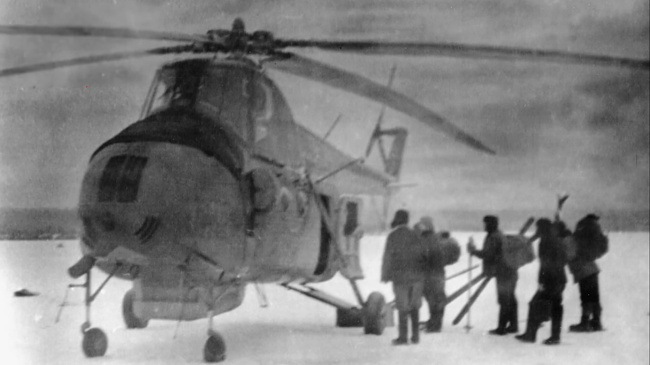
Slobtsov's search group in Ivdel boarding a helicopter 31510 from 123rd flight detachment with commander Pustobaev.
On the morning of February 23, Maslennikov reported to Ufimtsev over the phone, but except for the information on the Slobtsov group’s departure by plane, there was no further news. At 9:00 AM a conference began at the UPI with Siunov, Andrey Vishnevskiy, Slobodin, and Zaostrovskiy, the Secretary of the UPI party committee, taking part. A message came from Ivdel that Mansi hunters had discovered the hiker’s campsite. A search team of geologists from the Northern Expedition moved to follow the track of the Dyatlov group. Three search groups of the Mansi hunters were sent along the Ural Ridge and to the vicinity of Mt. Oyko Chakur and Mt. Otorten. Maslennikov was summoned to a conference, which lasted until midnight. Information was received that the Slobtsov search group was dropped off in the vicinity of Mt. Otorten. It was decided to send a second UPI group to Ivdel to search in the vicinity of Mt. Oyko Chakur. Oleg Grebennik, a 4th year student of the Department of Mechanical Engineering and an experienced mountaineer, was offered to lead that group. In 1958, Oleg traveled to Austria as a member of the Sverdlovsk mountaineering team and had the "USSR Mountaineer" badge received at the "Ullu-Tau" alpine camp in the Elbrus region. According to the recollection of Grebennik, after his return from an expedition to Kazakhstan, he learned that the Dyatlov group had disappeared, and a search group had already been sent to follow its track. At the UPI sports club, Grebennik was asked to organize a group to track the final part of the Dyatlov group's route, from the Otorten back. The members of the newly organized search group spent the night at the UPI labor union committee. Flying out was scheduled for the next day. Throughout the night, they were packing their equipment and food supplies. The UPI students helped to prepare food rations; one of those students was Kira Obodova, a 4th year student of the Department of Radio Engineering and the future wife of Oleg Grebennik. She was a member of the Blinov group, that had traveled together with the Dyatlov group to Vizhay. Ortyukov was in charge of the travel arrangements. There was an orientation session for the members of the search group on the premises of the UPI labor union committee; Maslennikov took part in the orientation session and agreed to leave for Ivdel as a consultant at the request of the Institute (see in article).
On February 24, the Sogrin group returned to Sverdlovsk from an expedition in the Subpolar Urals. They had not managed to carry out all of their scheduled tasks. They were supposed to go through a 500 km circular route, including path-breaking winter ascents to the peaks of the Sablya, Neroyka, and Telpoz-Iz Mountains. However, several emergencies caused a change in their plans. In the very first days, their tent was burned down, hence the hikers had to spend the remaining nights in snow bivouacs. The many-day-long blizzard and the sickness of one of the hikers forced the group to go back along their contingency route. Nevertheless, theirs was the world's first winter ascent on both the Sablya and the Neroyka.
Around 11:00 AM, the UPI second search group departed for Ivdel. It included Oleg Grebennik, Vladimir Shlyapin, Ivan Tatsienko, Vladimir Skachkov, Vladislav Kirsanov, and Victor Kostrulin. The group included experienced mountaineers and hunters. For instance, in 1957 Tatsienko met the standards for the "Mountaineer of the USSR" badge at the "Varzob" alpine camp, and next year he was elected chairman of the UPI mountaineering section. He was a participant in the first UPI Alpinists’ academic competition, went through a training camp for junior mountaineering instructors at the "Dzhan-Tugan" alpine camp. Shlyapin was taught by his father about life in the taiga from early childhood. From the age of 14, he was hunting and going in for hiking and mountaineering. The search party was joined by the UPI Deputy Rector Nikolay Fyodorovich Pletnev, as well as by Zaostrovskiy, Vishnevskiy, Maslennikov, and Ortyukov, who had already appeared in this story. There were 12 people on the plane in total.
Colonel Ortyukov was entrusted with coordinating the activities of civilian and military searchers and aviators, maintaining contact with the search groups, local and regional authorities, and the UPI administration. In the morning, before the departure from Sverdlovsk, Ortyukov had already met with the Military District’s Air Force Commander, Lieutenant General of Aviation David Slobozhan, arranging the allocation of one aircraft and two helicopters for reconnaissance by the Ural Military District.
The transportation of the UPI search party to the Uktus airfield was provided by the Institute. Stanislav Tipikin, at the time a 5th year student of the Department of Physics and Technology, would later recall that, in general, the organization of the departure was not ideal. An experienced hiker, who had previously been elected chairman of the bureau of the UPI mountaineering club, Tipikin was part of the Grebennik search group, but couldn’t fly out on that day due to the aircraft overload. His equipment, including his rifle, flew away to Ivdel, loaded along with other luggage. The UPI sports club would return his rifle in a broken condition after a month and a half; they would not be able to find the cartridges and his other belongings altogether. Tipikin would be able to fly away to join the search only the following day.
We cannot rule out that Yuri Yarovoy, a newspaperman, head of the department of the Na smenu! ("On duty!") daily, the official publication of the Sverdlovsk regional committee of the Komsomol flew as number twelve together with the UPI representatives. He might have been dispatched to supervise the progress of the search. Likely that was the reason why there was no seat for Tipikin. It was customary for the Komsomol to send an internal informant to observe and document operations like this. According to existing recollections, following his return from the search operation, Yarovoy gave an account of the details of the search to the regional Komsomol and party committees.
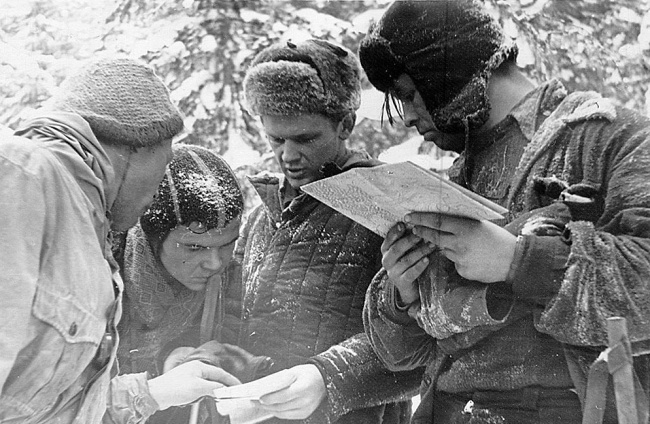 Sharavin, Lebedev, Slobtsov, and Halizov reading Ortyukov's instructions dropped from the air and checking the map.
Sharavin, Lebedev, Slobtsov, and Halizov reading Ortyukov's instructions dropped from the air and checking the map.In the morning of February 25, the Slobtsov group continued moving southward along the Matveevskaya Parma, as the Russians called the Charkanur ridge, which stretches between the Lozva and the Auspiya rivers. Descending from the ridge into the valley of the Auspiya River, the searchers came across an old ski track on the northern bank of the river. They set up their camp at that location. The discovered ski track was barely discernible. For any reliable identification, it was critical to discover the campsite of the Dyatlov group. The search party was broken into three groups. One of the groups led by Koptelov stayed back at the camp doing the chores. The Brusnitsyn group was moving along the discovered ski track down the Auspiya River; in about 17-20 km (10-12 miles) east of the Ural Ridge it saw the traces of an old campsite. Moving further, in one kilometer from it they came across a relatively recent Mansi encampment. A team of Slobtsov, Sharavin, and Halizov, who were sent to follow the westward leading ski track, lost it at the border of the forest. By the evening, all search parties gathered in their camp.
At the same time, the air search continued. The Slobtsov group was brought up to date on the latest developments. At 9 am, even earlier than planned, a search party consisting of four Mansi hunters and Egor Nevolin, the radio operator, departed from Suevatpaul on three teams of harnessed reindeer and four sleds. The group was led by Stepan Kurikov. The group also included Nikolay Anyamov, Andrey Anyamov, and Timofey Bahtiyarov.
The Grebennik search group was dropped off by helicopter in the area of the peak of Mt. Oyko Chakur. The group landed in the headwaters of the Vizhay River, along which they were to proceed towards the Ural Ridge. To be on the safe side, they were given a hunting gun. The gun and its owner, Tipikin, missed each other, as in the evening Tipikin arrived in Ivdel as part of the Akselrod group.
At 7 pm a meeting of the search headquarters was convened to discuss the immediate goals. Its participants included Ortyukov, Maslennikov, Vishnevskiy, Blinov, Akselrod, as well as Yakov Busygin and Aleksey Chernyshev, the representatives of the command of the 32nd division of the detainee security of the MVD of the USSR, which was guarding the local corrective labor camps. Chernyshev was assigned with the organization of a search group.
In the morning of February 26, the Slobtsov group was divided into three search parties. Koptelov had stayed in the camp. Two groups were searching for the ski tracks left by the Dyatlov group in the southern direction, along the right bank of the Auspiya River. Slobtsov, Sharavin, and Pashin were going in a north-western direction up the Auspiya River along the ski track on its left bank, and then proceeded from the border of the forest towards a rock pillar at the pass. The weather was improving. The sun came out, but the wind was strong. On the pretext of bad weather, Pashin had remained at the rock pillar. Slobtsov and Sharavin were advancing towards the northern offshoot of height 1079, when they noticed a dark object on their left, in about 50 meters (164 feet) along their path.
The tent was snowed up, except for the entrance, the southern abutting end, which was sticking out from under the snow. The tent’s canvas was covered with hardened swelled up snow 15-20 cm (4-6 in) deep. There was an ice-ax stuck near the entrance and a flashlight on the tent’s top, closer to the entrance. There was around 5-10 cm (2-4 in) of snow under it; however, the flashlight itself was not snowed up. No other items were noticed outside the tent. Below, to the east from the tent, there was a visible section of snow, which looked as if lowered or blown out or flattened, about 7 m (23 feet) wide.
There is no reliable information regarding the immediate manipulations of the searchers with the tent immediately after its discovery. Slobtsov and Sharavin would later recall that they had dug a groove along the tent, partially removed the snow from the canvas, discovering a cut in its eastern slope. With the help of an ice-ax, they tore the canvas along the ridgepole of the tent, so as to gain access inside the tent. After making sure that there was no one in the tent, Slobtsov and Sharavin headed back to the base camp. According to various testimonies and recollections, they brought the items discovered during the inspection of the tent – the ice-ax, flashlight, storm jacket, which was sticking out near the tent’s entrance, photo cameras, and a flask of alcohol – to the camp. For a while, Pashin was returning with them from the pass, but by the end of the route, he was lagging behind. In the camp, they met the Mansi group with the radio operator and received a drop message with new the instructions sent by the search headquarters.
At 6 pm the radio station of the Northern Expedition received a radiogram reporting the discovery of the tent. Its further inspection has turned impossible due to the onset of a severe snowstorm. The Slobtsov group received instructions not to touch the discovered tent; the next morning they were to select a place for the base camp and to prepare a landing site. It was decided to send the Karelin group to the location of the discovery of the tent to assist in the further search.
The searchers at the Auspiya River had lots of work to do. The day before, they received an assignment to setup a landing site and to choose a camping spot for 50 people. It was decided to look for the campsite closer to the discovered tent. Sharavin and Yuri Koptelov had already reached the pass between heights 1079 and 880 when at the Ivdel search headquarters it had dawned on them that the traces left by the search parties could interfere with the work of the K9 units from the military unit 6602. The dog handlers, led by Sr. Lieutenant Moiseev, were already preparing to fly from Ivdel together with the Karelin group.
"To Nevolin: Try to catch up by deer or skiing with the group gone to demount the tent for the arrival of the dogs. Sulman" Case files 150
"To Ortyukov and Sulman: We are informing you that the search in the location of the tent of the Dyatlov group started yesterday. Today four men have already left for the search. If we manage to catch up with them, we will tell them to halt the search until the arrival of the dogs. Slobtsov" Case files 147
They had not managed to catch up with the searchers. Under the cedar, at a distance of about one mile from the tent, which was discovered the previous day, Sharavin and Koptelov stumbled upon two bodies. At 1:00 pm Slobtsov reported to Ivdel the discovery of the first corpses.
From Atmanaki’s testimony Case files 214: "At 12:00 pm, we boarded a helicopter and landed on the saddle at the height 880. The group included four hikers and two guides with dogs. Our task was to divide ourselves into two groups and to find an appropriate place for the base camp in the basin of the Lozva River, while the second group with the dogs will begin scouring the site from the tent down to the Lozva River. After leaving our skis and equipment at the pass, Borisov, guides Moiseev and Mostovoy, and I went along the slope in the direction of height 1079. At the pass, we met several people from the Slobtsov group, who gave us a tentative location of the tent of the Dyatlov group. The remaining members of the Slobtsov group were at the pass at the stone ridges. Subsequently, it became apparent that the discovery of the tent and the bodies of their friends had made such a deep effect upon them, that they were completely demoralized and incapacitated. Together with two men from the Slobtsov team and the guides, Borisov and I have combed the slope below and to the right of the tent. On our way, we met two Mansi men and the chief of the Ivdel fire brigade. They told us that two corpses had been discovered about two kilometers below and then showed us the location of the tent... Following the examination of the tent, we went down, indicating to the Slobtsov men the contemplated place for the base camp and instructing them to go down to that place and to move the equipment to that place."
On this day all hope was lost. The bodies of Doroshenko, Krivonischenko (by Sharavin and Koptelov), Dyatlov (mansi Kurikov group) and Kolmogorova (by Moiseev's rescue dog) were found. This plunged their comrades into despair. They were not seasoned rescuers, and didn't go to the pass expecting to recover bodies. Their spirits were broken and they were overwhelmed with sorrow.
If you can stomach photos from this day here is the whole film from Ivanov's archive
Featured
What happened on February 27 (the day after the tent was found)?
The official version of events is as follows:
- the discovery of the Dyatlov group tent was reported in Ivdel on Nevolin’s radio in the evening the day before;
- in the morning Koptelov and Sharavin went to the pass and found two bodies under a cedar;
- they returned from the cedar to the pass because they heard the sound of an approaching helicopter. Sharavin meets the helicopter. In the helicopter are the searchers who flew to the pass, because yesterday they received a radiogram about the discovery of the tent. And it’s clear that they have to look for the missing hikers nearby. So far everything sounds normal.
Then things get weird:
- soon a second helicopter arrives. It brings Tempalov, Maslennikov, Yarovoy, etc.
- recollections of Koptelov and Sharavin over the years (published below) give us the time between the arrivals of helicopters from several minutes to tens of minutes. But in all versions Koptelov meets the second helicopter, because Sharavin was busy with the searchers who arrived on the first helicopter. According to different versions after returning from the cedar, Sharavin went to the first helicopter, and Koptelov to the second (the helicopters arrived almost simultaneously), or Sharavin approached the helicopter, and Koptelov ran to the camp, told about the corpses found and returned to the pass, where he saw a second helicopter was approaching and went on to meet it. The most interesting thing is that Tempalov and others flew to the pass after radiogram about the discovery of ONE BODY. And the discovery of this one body was not reported to Ivdel from Koptelov. Because he told the camp about the discovery of 2 bodies and the helicopter would not have had time to fly to the pass at the same time as Koptelov’s return there. Moreover, both helicopters arrived almost simultaneously. Grigoriev generally wrote about it like this: "We found Dyatlov. We gathered for the pass. A helicopter came."
It looks like someone went to the pass either together with Koptelov and Sharavin, or BEFORE them. And this is clear from Slobtsov's radiogram - that in the morning FOUR people went to the tent (and we know only two). These someone found а corpse (most likely Dyatlov), managed to report this to the camp before Koptelov returned there, and based on this, a helicopter with a prosecutor flew to the pass.
But in the official version of events is different: first they found the two Yuris under a cedar tree, and then two more bodies on the slope (Dyatlov and Kolmogorova).
At least two people know about this: Nevolin, because he transmitted the radiogram to Ivdel, and Tempalov.
Perhaps Lev Ivanov could have noticed the discrepancy in Tempalov’s testimony, but since mid-March Ivanov has practically not been involved in this investigation.
Смотрите всем известная картина 27.02 (на следующий день после находки палатки).
Официальная версия событий такая:
- накануне была найдена палатка, вечером об этом сообщили по рации Неволина в Ивдель
- с утра Коптелов и Шаравин пошли на перевал и нашли тела под кедром
- от кедра вернулись на перевал, т.к услышали звук подлетающего вертолета. Вертолет встречает Шаравин. В вертолете - поисковики, которые прилетели на перевал, т.к вчера была получена радиограмма о найденной палатке. И понятно, что туристов нужно искать неподалеку. Пока все складывается.
А вот дальше начинаются странности:
- вскоре прилетает второй вертолет. В нем - Темпалов, Масленников, Яровой и т.д.
- по разным вариантам рассказов Коптелова и Шаравина между прилетами вертолетов от нескольких минут до десятков минут. Но во всех вариантах второй вертолет встречал Коптелов, т.к Шаравин был занят с поисковиками, прилетевшими на первом вертолете. По разным вариантам: после возвращения от кедра Шаравин пошел к первому вертолету, а Коптелов - ко второму (вертолеты прилетели практически одновременно), или же Шаравин подошел к вертолету, а Коптелов добежал до лагеря, рассказал о найденных трупах и вернулся на перевал, где увидел подлетавший второй вертолет, который и встретил. Самое интересное: Темпалов и прочие вылетели на перевал после радиограммы о находке тела. Одного тела! И о находке этого одного тела в Ивдель сообщили не от Коптелова. Потому, что он рассказал в лагере о находке 2-х тел и вертолет не успел бы прилететь на перевал одновременно с возвращением туда Коптелова. Тем более - в варианте, если оба вертолета прилетели практически одновременно. Григорьев вообще писал об этом так: "Нашли Дятлова. Собрались на перевал. Пришел вертолет".
- т.е очевидно, что кто-то вышел на перевал или вместе с Коптеловым-Шаравиным, или ДО них. И это ясно из радиограммы Слобцова - что утром ЧЕТЫРЕ человека вышли к палатке (а мы знаем только двоих). Эти кто-то нашли какой-то труп (скорее всего Дятлова), успели сообщить об этом в лагерь до возвращения туда Коптелова, и на основании этого на перевал вылетел вертолет с прокурором.
Но в официальной версии событий все не так: сначала нашли Юр под кедром, а потом уже тела на склоне (включая Дятлова).
Почему? И об этом знают как минимум 2 человека: Неволин, т.к передавал радиограмму в Ивдель, и Темпалов.
Странности в показаниях Темпалова возможно мог бы заметить Л.Иванов, но с середины марта он уже практически не занимался этим делом.
Vadim Brusnitsyn interview 2007
Vadim Brusnitsyn took the items out of the tent. He was constantly distracted and did not protocol what he was doing. Soon after they began stripping down the tent there was an order to to put everything back inside the tent and bring it to the landing site. Brusnitsyn and Sharavin dragged the tent with its contents for half a mile towards the rock outlier where now hangs the memorial plaque. As he took most of the photographs, he is rarely pictured in any.
Yuri Koptelov excerpts from an interview with Channel 1, 2013
The most recent interview of Yuri Koptelov. Note that he is not budging regarding the position of the bodies throughout the years. Memories fade, or deepen something you remember wrong to start with. Why is he insisting that Slobodin was found while he was on the pass and loaded his body... Koptelov is often cited about the snow cover on the bodies and fire under the cedar. So I thought we might as well have the sources handy.
Yuri Koptelov's recollections 2011
Koptelov is hardly in any photos. You can see him in the base camp photo session with a mug and spoon at the far right. He likes to squat maybe because he is usually the tallest in the group. Yuri Koptelov calls himself "the fifth wheel", he didn't know anyone and no one remembered to warn him what not to do or say, no one remembered to question him since he and Mihail Sharavin found the bodies and Sharavin was hospitalized after a ski accident when the testimonies were taken. It is almost as if Koptelov was never there, and his account of events is almost as if he is talking about a different cedar and the position of the bodies is different, and he says he loaded 5 bodies in the helicopter before the fifth body (Slobodin) was found. What gives?
The story behind this picture is in Koptelov's recollections. The dating of the photo is also now possible because Koptelov was at the tent with Karelin when the latter just arrived on the pass with a helicopter on February 27. Koptelov didn't know Karelin. He only learned after the photo was published in the public domain who he took to the tent right after he found and reported that he and Mihail Sharavin had found the first bodies. Isn't it strange that they asked him to take them to the tent and not the bodies since the tent was visible from the landing site and the bodies were somewhere in the ravine? No one knew about the cedar or where to look. In the following days the mystery will deepen, meaning I will publish more recollections from Koptelov and cross check them with other sources. Can you see the discrepancies?
By February 28, the aircraft of the 142nd detached mixed aviation squadron (OSAE) of the Ural military district with a base at Aramil, had arrived in Ivdel. The An-2 was piloted by Sr. Lieutenant Vladimir Savvich Kuznetsov. The crew included Captain Vasiliy Yegorovich Serebryakov as navigator and Burdasov as a flight mechanic. Victor Vasilyevich Potyazhenko, deputy squadron commander, arrived by Mi-4 helicopter. Its crew included navigator Mihail Ivanovich Novikov and flight mechanic Valentin Petrovich Kovtun.
Potyazhenko would later recall that they arrived in Ivdel at around noon on February 27. Mihail Gorlachenko, the Chief of Staff of the Air Force of the Ural Military District, arrived with them. After a conference and setting up of the Ivdel-Aramil telephone line, Gorlachenko made an overflight of the search area. On ascertaining the safety of using helicopters, he returned to Sverdlovsk. Appointed as the senior in command, Potyazhenko received an instruction, which obliged him to file applications for each flight and to obtain approval of the route from Aramil by phone. The second Mi-4 helicopter of the 142nd OSAE would arrive in Ivdel on February 28. From that day on, search operations would be conducted only by military aviation. At 9:20 am Sr. Lieutenant Kuznetsov flew off by AN-2 to drop canisters to the Grebennik and Akselrod groups with information on the group’s evacuation procedures – with Ortyukov, Vishnevskiy, and Grigoriev, the correspondent of "Ural Worker", onboard.
In the morning, Tempalov, Chernyshev, and about ten more men, including Maslennikov, Brusnitsyn, Sharavin, Lebedev, Karelin, Atmanaki, and Koptelov, went to dig out the tent. Maslennikov instructed Brusnitsyn to make a list of items recovered in the process of digging out the tent, but the latter was continuously distracted by other matters and could not keep a systematic record. There was no thorough examination of the items on site – they would be properly protocolled only in Ivdel. Soon after they began stripping down the tent: there was an order to wind down the inspection of its contents, to put everything back inside the tent, and to bring it to the landing site. Brusnitsyn and Sharavin dragged the tent with its contents for half a mile towards the rock outlier now known as the Boot rock. Three of the four discovered corpses were as well moved up to the pass under heavy wind. The corpses were taken uphill by eight people so that not to damage the frozen bodies. The body of Krivonischenko would be moved to the pass only on March 1.
"To Sulman: Thus far we have been unable to find anyone else. We have dug out the tent, sorted out their belongings in Dyatlov’s tent ... There are all the nine backpacks, several storm jackets, 3.5 pairs of felt boots, eight pairs of boots (one pair is missing), and other personal belongings. There is also some part of food supplies, but not all. The remaining part of food supplies should be somewhere else... At the time, they are compiling a protocol. We are moving the corpses up to the ridge to be sent by helicopter. Maslennikov, Nevolin" Case files 158-159-160
From the protocol of the site where the Dyatlov group campsite was discovered Case files 2: "The overnight campsite is located on the North-Eastern slope of height 1079 in the headwaters of the Auspiya River. The overnight campsite is 300 meters from the top of height 1079 downhill at 30 degrees. The overnight campsite is a platform of flattened snow, with eight pairs of skis lined up in its bottom. The tent is stretched on ski poles and fixed with ropes. Inside, there are nine backpacks with various personal belongings of group members on the floor of the tent. On top of them, there are padded jackets, storm jackets, and nine pairs of boots at the head. We have also discovered men's trousers, three pairs of felt boots, warm fur jackets, socks, a cap, ski caps, dishes, buckets, a stove, axes, saws, blankets, and the following food supplies: rusks in two bags, condensed milk, sugar, ready-made-food, as well as notepads, pre-planned itinerary and a multitude of other small items and documents, including a camera and its accessories. All discovered items have been handed over to Maslennikov, the leader of the search team, for inventory and submission to the base camp, in which this protocol has been made. No corpses were discovered inside the tent."
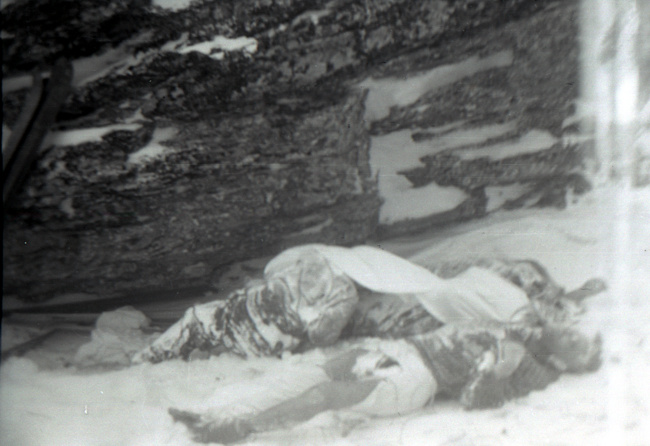 Bodies at the outlier rock. The farthest is Doroshenko; Kolmogorova lies, leaning against Dyatlov (under the sheet); Krivonischenko is in the foreground.
Bodies at the outlier rock. The farthest is Doroshenko; Kolmogorova lies, leaning against Dyatlov (under the sheet); Krivonischenko is in the foreground.There was no longer any optimism about the likelihood of finding the rest: "To Sulman: We believe this day to be the final one. We are going to check with the probes the entire area covered with deep snow. If we do not find anything with the probes, we will have to wait until spring. No one could have made it beyond this place. In some places, the snow is more than two meters deep... Today four men will be looking for the cache site. All the rest are going to search for the missing hikers. Maslennikov" Case files 170
The opinion at the search headquarters was different: "To Maslennikov: We consider it vital to continue the search now until we discover all other hikers. There is a suggestion to send sappers with mine detectors to assist you. Give another consideration of the option of sending dogs. The nasty weather will not put the searches at risk. There has been no severe local weather warning for the coming days. Sulman, Zaostrovskiy" Case files 162
That optimistic forecast has not turned true. Two helicopter flights were scheduled for March 1 to evacuate the discovered corpses and the property of the deceased group from the pass. It was also planned to send Moiseev, Mostovoy, and Chernousov back from the pass. But due to the deterioration of the weather, they could only make one flight: to transport Ivanov, Akselrod, Sogrin, and Tipikin from Ivdel to the pass.
In the morning, during breakfast in Ivdel, they learned that the Akselrod group was returning to Sverdlovsk. Tipikin would later recall: "Due to the absence of radio communication, the change of the February 26 landing site at Mt. Otorten, as well as the absence of information about it at the search headquarters, it was reported to Sverdlovsk that the Akselrod group might have died as well. To avoid negative consequences, it was ordered to bring the searchers to the Institute so that to prove to their relatives that they were alive." Only after lengthy discussions, the Akselrod group was permitted to fly to height 1079 to continue the search.
Sogrin would later recall: "On the flight to the pass, we met prosecutor Lev Ivanov. The helicopter was carrying food supplies. After landing, we saw a tent under the rock pillar, as well as the bodies that the searchers brought up the mountain the day before. The helicopter was met by the members of the Slobtsov group and some people we did not know, most of whom departed with the return flight." Before joining the search, the Akselrod group had loaded the tent and the Dyatlov group’s belongings into the helicopter. Some of the items were left behind and would be sent to Ivdel later.
Maslennikov asked Sogrin to accompany Ivanov and to brief him on the basics of mountaineering. They immediately went to the site of the tent’s discovery. There were neither animal nor human traces around, except for the area that had been trampled by the searchers while removing the tent. The same was observed downwards in the area around the cedar. Having examined the tent site, Maslennikov, Ivanov, and Sogrin retraced the Dyatlov group passage all the way to the cedar. Footprints with visible finger-marks were leading down the slope to the ice blister, of around 200 meters in size, which was formed by the discharge of subsurface water. Below the ice blister, one could see barely discernible traces, which had become closely-grouped and short in size. Having approached the cedar, Ivanov noted that the body of Krivonischenko was in a typical position of an exhausted man.
By 4 pm, the search was completed. On the way back to the base camp, the body of Krivonischenko was taken up to the landing site by a group of five or six men, who were pulling it on a drag sled. On the way back to the camp they took with them the food supplies, which had been delivered earlier in the afternoon.
"To Sulman: Today, we have continued the search, despite a sudden deterioration of the weather conditions. We have covered about 1000 meters of a 30 meter wide zone around the area of the tent site. The search has not yielded anything. The snow is one-two or more meters deep. Today the wind has reached 30 meters per second with no visibility. It is impossible to continue the search in such weather. As far as the advisability of a subsequent search, we may say that even in fine weather the search in this area may turn up useless. It would require at least 100 participants. Had the weather been fine, it would have been possible to check one or two more sections. Maslennikov" Case files 169
At the headquarters, they were insisting on continuing the search. "To Sulman: We can continue the search, but half of the group should be replaced with fresh manpower. It is necessary to replace the Slobtsov group and the Mansi men. Sappers will be more useful with probes than with mine detectors since there are no metal objects on the bodies under the snow. We need about 20 pieces of 2.5 meter long probes. According to the current weather forecast, we should expect severe weather conditions on March 2-4. A blizzard is raging right behind our tent, and the weather is getting worse hour after hour. Maslennikov" Case files 166
"To Maslennikov: In case of flight weather, a helicopter will arrive at your place at 1:00 pm. Prepare for shipping the corpses and of anyone who may be sick and not needed for work. We agree with your suggestion. Measures will be taken to send replacements for the group up to March 2-3. Sulman, Zaostrovskiy, Ortyukov" Case files 163
From the morning of March 2, the pass was under a blizzard with no visibility. The arrival of helicopters was questionable. "To Sulman: Today we will be looking for the cache site at the headwaters of the Auspiya River. We are sending the men on duty to the landing site in case a helicopter arrives. We are also sending a group to go over the pass in search of the victims. We will send Ivanov, Yarovoy, and the four corpses with the first flight. The second flight should take six men from the Slobtsov group... In our and Nevolin’s opinion, you should not replace the Mansi men... I deem it expedient to assign Captain Chernyshev as the leader of the search team, particularly that the team is becoming military in composition. The team and Chernyshev are in agreement on this issue. An issue of the removal of Blinov, Borisov, and Serdityh has also been raised. Maslennikov"
The weather did not allow any flights. The corpses would remain under the Boot rock near the landing site until March 3. The search participants were coming up with more and more theories of the death of the hikers: "To Sulman: It would be helpful to ascertain whether a meteorological rocket of a new type flew over the area of the accident on the night of February 1. Maslennikov"
In the evening, the search headquarters received the daily report: "To Sulman: Today the search in the Lozva valley has failed. Twenty-two people climbed up the pass and had to return due to a snowstorm. There is no visibility. Instead, they have stored firewood, reinforced the camp, and prepared it for the arrival of the replacement. The search group of Slobtsov and Kurikov has discovered the Dyatlov group’s cache 400 meters from our tent, higher up the Auspiya River. The cache was found to contain 19 food items with a total weight of 55 kg, as well as an emergency medicine box, Dyatlov's insulated boots, one pair of ski boots, a mandolin, a set of batteries with bulbs, and a spare set of skis. The coordinates of the cache site have been sent to you. Maslennikov"
The cache site was discovered 10 meters (32 feet) from the ski track leading from the base camp to the pass. This is the protocol of the examination of the cache site aka labaz:
The snowstorm continued throughout the whole day of March 3, with wind up to 25 meters per second, visibility of 5 to 8 meters. From the morning the Mansi men were returning to Suevatpaul. In the opinion of Nevolin and Maslennikov, their continuous presence was not advisable. Stepan Kurikov was the only one among the Mansi men who was directly involved in the search, the rest of the Mansi men were mainly doing household chores. On Tempalov’s instruction, Nevolin was to stay in the camp. Radiograms from March 3
Despite bad weather, two helicopters arrived between 11:00 am and 12:00 pm with an interval of 20-30 minutes. Potyazhenko landed a group of sappers from the railway forces at the pass. The requested long metal probes were not sent. The four corpses and the recovered items from the cache were transported to Ivdel. Ivanov and Yarovoy left as well. The second helicopter damaged its support during the landing and was unable to land at the pass. The students from the Slobtsov group, who were waiting to be sent home, had to stay in the camp for the time being.
When delivered to Ivdel, the bodies were transported from the airport to the N-240 Central hospital serving the administration staff of N-240 and placed in the morgue. The driver of the truck was Stolyarov, the driver of the Northern Expedition, who had been detailed to the Ivdel airport sometime before the beginning of the search for the missing hikers. By around 2:00 pm Pletnev and Vishnevskiy had completed their list of items brought from the cache site. In the morning, with the help of Grigoriev, they had already completed their inventory of the group’s belongings, which were brought to Ivdel on March 1. Grigoriev was copying Kolmogorova’s diary for his own use, with Vishnevskiy gathering the letters, a satchel with documents, money, diaries, and watches.
Following the accident with the helicopter at the pass, Gorlachenko urgently flew to Ivdel. The damaged part of the helicopter was taken to Polunochnoe for welding. The Kaunas crew was removed from the search and returned to Sverdlovsk. Due to the ground elevation profile, the airplanes were no longer considered as an option. Potyazhenko was the only one left to take part in the search. As per flight regulations, after doing 25 to 30 flying hours, helicopters had to fly back to Aramil for routine maintenance. Per flying shift, helicopters could make about seven flights to the pass, after which the helicopter had to be replaced. In total, three Mi-4 helicopters were used in the search, with tail numbers 14, 16, and 68. Flight mechanics and navigators were also alternating. Potyazhenko was flying with flight mechanics named Nikolay Nemyko, Valentin Kovtun, and Potegov; pilot-navigators Mihail Novikov, Valerian Ovchinnikov, and Babenko.
In the afternoon, the remaining part of the sappers of the 5th railway brigade was transported to the pass. In total, their group included eight men: Lt.- Colonel Shestopalov, Lieutenant Vladimir Avenburg with the servicemen of the mine warfare platoon of the 2nd company of the 52nd detached railway battalion – sergeant Y. Savelyev, corporal L. Tymkiv, enlisted men M. Mordonov, V. Vasilchenko, V. Kudin, and N. Golubev. The question is what was a "What was a Human Intelligence Collector doing on the pass searching for the missing hikers?" The members of the Routing Qualification Commission of the Presidium of the All-Union hiking section Kirill Bardin, Master of Sports of the USSR, and Evgeniy Shuleshko, 1st degree "Tourist of the USSR", arrived with the same flight. They were accompanied by the representative of the central council of the Burevestnik voluntary sports society Semyon Baskin, Master of Sports of the USSR, and Vasiliy Korolyov, the chairman of the routing qualification commission of the Sverdlovsk city committee for physical culture and sports, 1st degree "Tourist of the USSR".
They arrived in Ivdel from Sverdlovsk the day before, on March 2. Vladimir Slobodin, the father of Rustem, flew together with the sports officials. He was still hoping for the better. Korolyov would later tell Grigoriev that Slobodin was questioning him if there were any hunters’ cabins or caves in the nearby mountains, where the hikers might be finding a refuge. Slobodin spent several days in Ivdel, talked to Aleksander Deryagin, the chairman of the city council. He had tried to break through to the bodies brought to Ivdel but was not let through the cordon at the Ivdel airfield. Soon he would return to Sverdlovsk, with his son’s body discovered at the pass the day after.
On its return flight, the helicopter took onboard six students from the Slobtsov group – Sharavin, Koptelov, Halizov, Devyatov, Krotov, and Strelnikov. From Ivdel, they went home to Sverdlovsk with a transfer in Serov. Slobtsov, Brusnitsyn, Lebedev, and Blinov had remained at the pass on the request of Ivanov so as to clarify the details of the early days of the search. Even further, Ivanov had taken Slobtsov’s personal and group diaries, which he was keeping during the search. Later, in Sverdlovsk, they would give official testimony.
"To Sulman: A group of eight sappers has arrived. They have safely reached the camp. The corpses have been sent by helicopter; the prosecutor and the correspondent have also departed. 17 men are taking part in the search. In the morning the weather was better, but now the wind is getting stronger. The search is going on ... The group led by Captain Vlasov has carefully examined the valley of the stream, at the source of which the accident with the Dyatlov group had taken place. The group reached the Lozva River. No traces of the Dyatlov group have been discovered. The stream is the place of snow drift from the main ridge, with very deep snow. There is no chance that a part of the group could go to the Lozva through this valley. Moiseev has thoroughly examined the area with his dogs. Another group continued to probe the slope. They have covered two hundred meters of deep snow, one hundred meters wide, along the ravine of the accident up to Kolmogorova’s body – without discovering anything. We have once again examined the site around the cedar ... The amount of work done and the places where spruce branches were cut give reason to assume that there might be someone else in addition to the two. Tomorrow we will subject this site to a more thorough inspection. On our way back from the search we met with the passengers of the second helicopter. We are all in one tent, there are still 30 of us. Tomorrow we will continue our search ... There is a section of one and a half kilometers long and 100 meters wide, which should be examined with probes. With this done, the work will be over, since there is nowhere else to search. This will take three days if the weather gets even worse ... Since the probes, despite our request, have not yet arrived, half of the team will be used for setting a landing site near the campsite ... It is necessary to prepare for the replacement of the remaining students with army personnel. Chernyshev, Nevolin, Maslennikov"
Radiograms from March 3
In his draft of the radiogram, Maslennikov assumed that the cut spruce branches might have been "used for a snow den, in which the rest are sleeping". However, this guess did not become part of the final radiogram. Malsennikov notebook 2 Had it been the bodies found only in May could have been recovered in March.
On March 4 the weather on the pass cleared. A group of ten cadets from the regimental school of military unit 6602 was sent to height 1079, under the command of Lieutenant Potapov. The probes had finally arrived, but they were too short. Blinov, Serdityh, Borisov, Shevkunov, Slobtsov, Brusnitsyn, and Lebedev were sent to Ivdel. They would get back to Sverdlovsk by airplane to return home earlier than the rest of the Slobtsov group, who were sent from Ivdel by train. At the time, Verhovskiy from the Chernyshev group was getting ready to leave – and Ortyukov was deeply dissatisfied with the departure of the students, mostly because it had not been discussed with him. (Photos from this day on the pass)

Shestopalov (group of 7) searched over the remaining bodies on March 4
In the center is the cedar and streams on both sides.
"In addition to the two military groups of Chernyshev and Shestopalov, a civilian group was organized – to be led by Akselrod. The personnel of the camp totals 34 men. The search went on. 31 men were working from 9:30 am to 6 pm. They had passed a 250-meter long and 300-meter wide territory. Another group began probing the area around the cedar. There they found a handkerchief, two and a half pairs of socks, and a torn sleeve cuff of a gray sweater. There is nothing else to say. Three men were preparing the landing site. Right near the tent, an area of 50 by 50 meters was chopped down. I had climbed to the ridge of the spur, under which the Dyatlov tent was pitched, and then to height 1079. No traces of an ascent were discovered. Mine detectors proved to be useless, hence the lt. colonel had immediately switched to probes. Maslennikov" Maslennikov notebook 2
The search in the area of the cedar was carried out by five men from the Shestopalov group, who had examined a site of 300 by 150 meters which included both streams. Sogrin, Akselrod, Bardin, Baskin, Shuleshko, and Korolyov, while examining the tent site specified that the slope had no hazard of snow slides. To facilitate the transportation of the belongings from the camp to the landing site, it was decided to move the landing site closer to the base camp. Tipikin would later recall that the site was being prepared in 200 meters (656 feet) to the east of their tent. They had begun to trample down the forest glade even before the arrival of the Akselrod group, but after a few days, the pilots decided it was not a safe landing site.
Maslennikov was told to prepare to report on the progress of the search, with the headquarters meeting scheduled for March 6 in Ivdel, where the inspection of the hikers' belongings brought from the pass was still underway. Among the belongings of the Dyatlov group, they discovered a hand-written issue of the group’s satirical leaflet they called The Evening Otorten №1, the last thing they wrote before they died.
In the presence of Nikolay Klinov, the prosecutor of the Sverdlovsk region, and lead investigator Lev Ivanov, forensic experts Boris Vozrozhdenniy and Yuri Laptev conducted the forensic medical examination of the corpses of Dyatlov, Doroshenko, Krivonischenko, and Kolmogorova at the morgue of the N-240 Central hospital.
The conclusions were uniform: "On the basis of the findings of the examination of the corpse ... and taking into consideration the circumstances of the case, we believe that the death ... resulted from the exposure to low temperatures (hypothermia) ... It was a violent death – a fatality."
Autopsy report of Yuri Doroshenko
Autopsy report of Georgiy Krivonischenko
Autopsy report of Igor Dyatlov
Autopsy report of Zina Kolmogorova
Gordo and K.V. Naskichev served as coroner’s witnesses. In fact, Naskichev's name was Filipp Aleksandrovich.
The news of the forensic examinations spread across the hospital, with its medical staff trying to peep into the morgue windows. As Zoya Nikitichna Savina, nurse’s aide at the hospital, would later recall she saw Yudin crying at the morgue’s door. As Yudin himself would later recall, he was summoned to the Sverdlovsk regional prosecutor's office for identification and dispatched to Ivdel. In the morgue, Yuri saw Dyatlov's body under a sheet, and a little later the still frozen corpse of Slobodin, which had just been transported from the pass.
In Ivdel on March 5, Yudin began to identify the belongings of the victims in the presence of Vishnevskiy and Yarovoy serving as coroner’s witnesses. The procedure continued until
"Today, it has again been windy with blowing snow. The wind is 15 m/s, with poor visibility. The team has been working particularly strenuously, covering an area of 500 meters long and from 250 to 150 meters wide. Halfway between the location of the bodies of Kolmogorova and Dyatlov, the fifth corpse is discovered under a 15 cm of snow. This is Rustem Slobodin, warmly dressed in a ski cap, black cotton sweater, pants, long underpants and three pairs of socks – with one foot in a black felt boot... There are several raw sores on the face and a wound on the wrist. He has a “Pobeda” wristwatch, which stopped at a quarter to nine. Lies head bent towards the mountain. A formal note of death is written up. Tomorrow afternoon we will take him up [to the landing site]. There is a 500 square meter plot left [to be searched]. All groups have been unified into a single group; we are walking with probes very close to each other in a 30 men front by separate quadrates along the ravine of the accident. We will proceed in the same manner tomorrow. Maslennikov" Maslennikov notebook 2
"On March 5, one of the participants of the deceased group, Rustem Slobodin, was found under snow, thick not less than 350 mm. He lay with his belly down, arms outstretched, on one of which - the right one, the joint of the thumb was bruised. The same hand had a watch. On the head a hat, on the basis of which I believe that at the time of death, there was not a particularly strong wind, since it would inevitably blow off the cap from his head if not while alive, then when Slobodin was already dead. One leg, the right (I can be mistaken) was in felt boot, the left without it, pulled up under the right leg. The face was very quiet, no evidence of violence was visible on external examination. Under the knees, chest, i.e. parts of the body to which the gravity of the person lying was distributed, there was a half-ice-half-snow layer about 70-80 mm thick, which led me to the conclusion that Slobodin did not die instantly, but was alive for some time after falling. Moisey Akselrod witness testimony
The next day, on March 6, Slobodin's body was transported to Ivdel. On the same day, the death of Dyatlov, Krivonischenko, Doroshenko, and Kolmogorova will be registered at the Ivdel civil registration office. In their death certificates the time of death is registered as February 1, 1959, with the place of death given as "in the mountain area of height 1079 in the Ivdel district", and the cause of death as "hypothermia during a hiking trip". Lev Gordo would receive the documents upon presentation of the certificate from the prosecutor of the city of Ivdel.
"[Today] the weather has not been favorable for the search. The search party has covered the entire valley of the creek, which is 250 meters long and 100 meters wide with nothing discovered. I have walked with a small group, along the forest border under height 880, along the ridge above the stream of the accident. Any escape of a part of the group from the cedar via this ridge is ruled out, because of the very deep loose snow all over the slope. Tomorrow we will probe the deep ravine 50 meters from the cedar, which is leading to the saddle between heights 880 and 1079. We will also probe for the second time the few sections at the upper part of the slope under the Dyatlov group’s tent. There is nowhere else to search at." Maslennikov notebook 2
Avalanche probes of 2.5-3 meters long (8-10 feet) were delivered to the pass. The probes had to be specially manufactured in Serov. Earlier they had to use ski poles or standard 70-centimeter (2.3 feet) sapper probes with wooden handles. The work on the new landing site near the camp at the Auspiya River was in progress. The makeup of the search party was changing. The six cadets from the regimental school of military unit 6602 in Lieutenant Potapov’s group were replaced. Verhovskiy from the Chernyshev's group and Lt. Colonel Shestopalov returned to Ivdel. Photos from this day on the pass
If you click on the Maslennikov's drawing to enlarge you can see the only word written with a blue pen says "Chum". This is where this photo was taken. According to Savva Bahtiyarov, the Mansi have permanent rest stop at the border of the forest, where they take breaks and make a fire. In order not to look for firewood next time, they cut birch branches making them the same length and dry them by leaning them in a shape of a "tent". According to Androsov this is a Mansi sacrificial place so that the wolves don't attack the herd, so that the deer do not get sick, so that there is a good offspring, so that there is a lot of food, and that the Mansi themselves are healthy.
"28 people continued to search all day long period No results in 450 meters under the tent found flashlight turned on comma 20 meters from the tent a piece of broken ski period Tomorrow March 8 is declared a day off period I think that the search must be stopped till the end of April period The weather is getting worse period Tomorrow with me fly three Muscovites, it is desirable to take off part of the civilians. Maslennikov" Case file 191
On March 8, Vozrozhdenniy was conducting a forensic medical examination of Slobodin's body at the same morgue of the N-240 Central hospital, in the presence of Klinov and Ivanov, with Gordo and Naskichev again serving as coroner’s witnesses. By that time, Laptev had already returned from Ivdel to Severouralsk.
"Based on the findings in the examination of the corpse of citizen Rustem Vladimirovich Slobodin, 23 years old, and considering the circumstances of the case, I believe that the death of Slobodin resulted from exposure to low temperature (hypothermia) ... The fracture of the left frontal bone discovered in an inlying examination could result from the fall of citizen Slobodin or a head contusion received from hitting against solid objects, such as stones, ice, etc. The said closed skull injury was caused by a blunt instrument. At the time it was inflicted, it no doubt had caused a state of short-term stupefaction and contributed to Slobodin’s rapid freezing. ... Slobodin died a violent death, in an accident." Autopsy report of Rustem Slobodin
At the pass, it was a day off. Maslennikov, Bardin, and Baskin flew to Ivdel to report to the emergency commission. From then on, the search party would be headed by Chernyshev. Maslennikov notes from this date
On March 9, Ivdel civil registry office will note Slobodin’s death and issue a death certificate. The fracture in Slobodin's skull gave grounds for a new theory. Grigoriev would later recall that there was an opinion that Slobodin might have been injured while climbing to the pass on February 1, which had caused the group to stop for the night on the slope of height 1079.
Based on the outcomes of the conference, the following instructions were sent from Ivdel to the pass: "March 9, 1959. Today you should continue the search across the strip of 30 by 50 meters around the examined sections of the ravine. Following the four-hour discussion of the findings up to date, it was decided to remove the team’s entire available personnel from the search within three or four days. Today, by 12:00 pm, the following comrades should be ready to fly out: Shuleshko, Sogrin, Akselrod, Atmanaki, Karelin, Yablonskih, Chernyshev, and Tipikin. The boarding will take place at the site on top of the ridge. For the evacuation days, comrades Potapov and Korolyov are assigned as leaders of the remaining part of the team. The landing site near the tent has been rejected due to insufficient clearance of the trees for approaching from the east. Take action. The Institute’s property should be accepted by Korolyov. The shipment of food supplies and equipment should be done last, and if necessary, left at the camp for subsequent groups." Radiogram from Maslennikov's 2nd notebook
The following stayed back at the search camp: Nevolin, Korolyov, ten men from Lt. Potapov’s military unit 6602 group, and seven of Lt. Avenburg’s railway sappers. Feliks Solomonovich, the chairman of the Ivdel sports committee, would later recall that no one from military unit 6602 was ordered to take part in the search. The search party is 31 men strong. After the replacements made on March 6-8, ten men comprised the group led by Lieutenant Potapov. Most of those sent to the pass were the athletes from among servicemen. Photos of the retreat from the search of Akselrod and Karelin groups
The search went on, with Solovyov from the Potapov group getting injured. "A 16 men strong search group proceeded along the right side of the ravine, a 20-meter wide strip, from the site of Kolmogorova's body to the cedar. We have double checked the ravine from the creek to the location where Slobodin's body was discovered. The groups of Moiseev and Borey with dogs searched through the nearby passes – with nothing discovered. For the next day, it was planned to survey the creek’s bed and the left side of the ravine. Potapov, Korolyov" Case files 198
In Sverdlovsk there were three funerals on this date. Yuri Doroshenko and Zina Kolmogorova found their last peace in Mihaylovskoe cemetery, and Yuri (Georgiy) Krivonischenko was buried in Ivanovskoe cemetery.
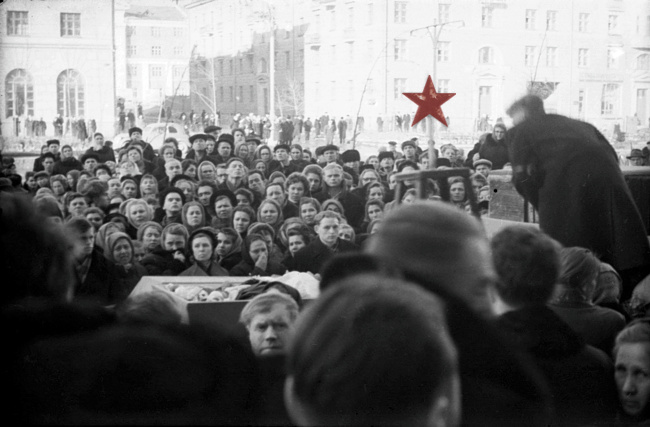
Photos of the procession and Mihaylovskoe cemetery
On March 10 in Ivdel, at a conference with the participation of the members of the party regional committee Filipp Ermash, Chernyshev, Vishnevskiy, Ortyukov, Ivanov, and Maslennikov, it was decided to organize two new groups of ten sappers and ten students to completely replace the military search team. The student group was to be ready by March 12-13. It was also decided to replace the radio operator, under the supervision of Captain Chernyshev, to relocate the search camp to the Lozva River’s fourth tributary. The camp would be relocated by the Blinov group only in April.
"We have examined the area around the cedar within the radius of 150 meters. We have searched through a section behind the ravine on the right side of the creek, which is 40 meters wide and 150 meters long. The search has not produced any findings. For tomorrow we are considering moving along the left side of the ravine from the location where Kolmogorova's body was discovered and further down. We believe it inadvisable to expand the search any further from around the cedar. Once again, please inform us of the exact date for the evacuation of the group. Potapov"
"Taking into consideration the maintenance of the helicopters, the replacement of the entire team will begin on March 12. Comrade Soloviev and the miners will be removed on the first day, with the remaining men on the second. The search should not be slowed down on those days. Pavlov" Radiogram from Maslennikov's 2nd notebook
Yudin returned to Sverdlovsk. He helped with transporting the biological tissue samples taken during the forensic examinations of the bodies. He would recall that a helicopter was detailed in Ivdel to fly to Sverdlovsk, with only two passengers onboard – a female expert and himself. In Sverdlovsk, they were met at the airport and taken to the laboratory of the Sverdlovsk regional bureau of forensic examination (SOBSME) on Rosa Luxemburg Street. There the probes were received undersigned receipt written by P.G. Chaschihina, an expert from the division of forensic medical examination of material evidence of the SOBSME; she had a long work experience at the chemical examination division of the city department of forensic service, which dated back to pre-WWII time.
Yudin couldn’t make it to the funeral of Dyatlov and Slobodin at the Mihaylovskoe cemetery, which took place in the morning.
March 9: Kolmogorova, Doroshenko and Krivonischenko
The authorities surrounded the funerals with lots of fog and omissions, which greatly overshadowed the already unpleasant event. At first the CPSU tried to persuade the parents of the dead to bury their children in Ivdel quickly and quietly. After the parents’ flat refusal, Vladimir Kuroedov, the secretary of the Sverdlovsk regional party committee, gave permission to bury the deceased in Sverdlovsk. Valenitn Yakimenko, student in UPI and participant in the search operation: "I hung up the announcement of the funerals in the foyer of the main building of the UPI. Half an hour later I was summoned by the party committee of the UPI, where the secretary, Kasuhin, reproached me for disturbance and made me remove the flyers. I refused, but someone took them now anyway. The reaction of the secretary of the party committee is incomprehensible, evidently he is afraid of something. March 9 - an update: Today will be buried only four people, and Yuri Krivonischenko, for some reason in another, Ivanovskoe cemetery, although his parents did not object to his son being buried with the others. We hung another announcement about the funerals. It was immediately taken down by someone. We are outraged. Decided everyone to go in their faculty and by course walk around each classroom and inform the students about the hour and place of the funerals."
Nina Panteleevna, wife of Konstantin Alekseevich, Krivonicshneko's older brother: ""Mother always kept under her bed a suitcase with Yuri’s belongings - a sweatshirt, mittens and a hat, from his last trip. A large portrait of Yuri hung in the room. On the day of his death, mother sat in front of his portrait and cried silently. I have to admit that we were afraid of this suitcase, fearing that the items inside could be radioactive. We had a child. But mother lived with this suitcase until 83 years of age and nothing. When she died we buried the suitcase." "After graduating from UPI, - Konstantin Alekseevich explained, - in the early summer of 1957, Yuri got a job at the now infamous Mayak plant. I don’t know exactly what my brother was doing there, he said that he had soldiers under his command. And soon at the enterprise there was an explosion of a storage. There was a fairly large emission of radiation. This is a known fact. It is quite possible that he brought this radiation on clothes from the enterprise. After all, if he had soldiers under his command, then he probably participated in the liquidation of the consequences of the explosion. After that, he quit, got transferred somewhere and went on vacation. He did not return from this vacation."
March 10: Dyatlov and Slobodin
March 10, Dyatlov and Slobodin are buried in Mihaylovskoe cemetery.
Yuri Bondarev, fifth year UPI student in 1959: "I was summoned to the Komsomol committee and told that I had to pick up the bodies of the dead from the Dyatlov group from the morgue and bring them to the funeral at the institute, and then to the cemetery. They asked if I might be uncomfortable doing this and that three men had already bailed out. I am not easily unnerved, so agreed. They gave me a truck, and I went to the morgue... I recognized Dyatlov first, although I had seen him only a couple of times before... The bodies in the coffins were loaded onto the open bed and was told to climb into the back and keep the coffins stable during the trip. This is how I rode all the way... There were a lot of people at the ceremony. I remember that Rustik's mother without raising her voice was muttering his name over and over again. His name was misspelled, the plaque having Ruslan, while his name is Rustem. I drew attention to this and asked to correct it. In general, all this made a very strong impression on me – I was absent for a week after... I didn't go to the second funerals [in May], the first ones were enough for me." Read the interview →
The five were laid to rest, the four were yet to be found.
Let's remember them for how they lived.

